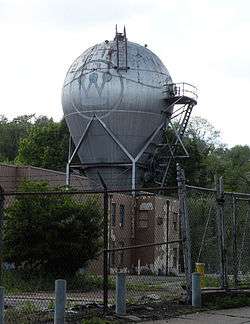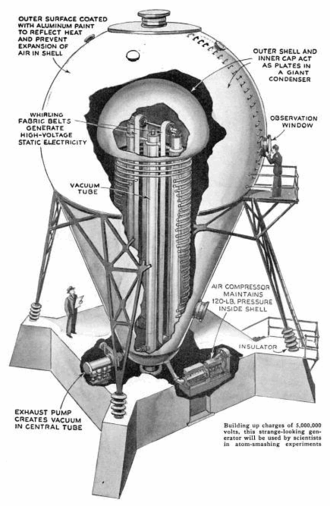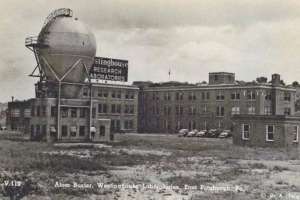Westinghouse Atom Smasher
The Westinghouse Atom Smasher was a 5 MeV Van de Graaff electrostatic nuclear accelerator operated by the Westinghouse Electric Corporation at their Research Laboratories in Forest Hills, Pennsylvania.[1] It was instrumental in the development in practical applications of nuclear science for energy production.[2][3][4] In particular, it was used in 1940 to discover the photofission of uranium and thorium.[5][6] It was the first industrial Van de Graaff generator in the world,[7] and marked the beginning of nuclear research for civilian applications.[8][9] Built in 1937, it was a 65 feet (20 m) tall pear-shaped tower.[7][10] It went dormant in 1958.[10] In 1985, it was named an Electrical Engineering Milestone by the Institute of Electrical and Electronics Engineers.[6]
| Westinghouse Atom Smasher | |
|---|---|
 The Atom Smasher on May 9, 2010, before the 2015 demolition | |
| General information | |
| Address | F Avenue & West |
| Town or city | Forest Hills, Pennsylvania |
| Coordinates | 40.4108661°N 79.8430295°W |
| Opened | 1937 |
| Closed | 1958 |
| Demolished | January 20, 2015 |
| Designated | August 28, 2010 |
How it worked


In a Van de Graaff generator, invented in 1929 by Robert J. Van de Graaff, an endless rubber or fabric belt carries electric charges from a roller at the base of the device and deposits them inside a hollow metal electrode at the top. This causes a high voltage to develop between electrodes at the top and bottom of the apparatus.[11]
In the Westinghouse machine, two high-speed belts traveled up a 47-foot shaft to a mushroom-shaped electrode near the top of the bulb-shaped enclosure, where electric charges were accumulated (see cutaway schematic).[12] Various ions, like those generated from hydrogen gas (protons) or helium gas (alpha particles), were injected into the upper part of an accelerator tube. The high electrostatic potential between the top and bottom of the tube then caused these subatomic particles to accelerate to extremely high velocities as they traveled down a 17-inch-diameter evacuated cylinder 40 feet in height, which was a sealed stack of many individual glass segments that collectively composed the largest vacuum tube in the world at the time of construction.[6] The accelerator tube ran between and parallel to the whirling belts to the base of the machine, where the accelerated particles bombarded experimental targets placed inside the tube, inducing various nuclear reactions.[11][13]
The energy of the particles was measured through the gamma rays that the beam produced when its particles hit a fluorine target, which was directly related to the voltage potential between the machine's electrodes.[13]
The maximum voltage that a Van de Graaff generator can produce is limited by leakage of the charge off the upper electrode due to corona discharge and arcing. At atmospheric pressure, a Van de Graaff machine is generally limited to around 1 megavolt. Thus this instrument was installed inside a pear-shaped 65-foot tall, 30-foot diameter air tank which was pressurized during operation to 120 pounds per square inch.[12] High pressure improved the insulating qualities of the air and reduced charge leakage, allowing the machine to achieve a voltage potential of 5 megavolts. This allowed a beam energy of 5 MeV, although it was originally hoped to reach 10 MeV.
Preservation efforts
In 2012, the property surrounding the atom smasher was purchased by P&L Investments, LLC.[1] The company was run by Gary Silversmith, a developer who intended to build apartments and expressed an interest in saving the smasher.[14] In 2013, the Young Preservationists Association of Pittsburgh named it as one of the city’s top 10 preservation opportunities.[14] During 2013, plans had been discussed of the Woodland Hills School District establishing a STEM educational facility with the atom smasher as the centerpiece, but the $4 to $5 million cost was prohibitive and the project never moved forward.[14]
By 2015, the structure was in significant disrepair and was dislodged from its supports, due to vandalism and age.[14] On January 20, 2015, Silversmith had the atom smasher removed from its supports and laid on its side.[2] Workers laid bricks to brace the fall, and tipped it over.[10] The demolition was decried by the Pittsburgh History & Landmarks Foundation and the mayor of Forest Hills.[14] Barry Cassidy, a friend of the developer who had worked since 2013 to secure grants to restore the smasher, resigned from the project after the demolition.[10][14] In an email to the Pittsburgh Post-Gazette, Silversmith pronounced his continuing commitment to refurbishing and restoring the atom smasher, saying "The iconic Atom Smasher bulb survives." [14]
In November, 2018, a Delaware non-profit was incorporated, Early Model Particle Accelerator Corporation. This corporation was created with the corporate mission to relocate and refurbish the Westinghouse Atom Smasher to its original form. The new mission is to provide facilities to support an educational and continued science research capacity. Gary Silversmith donated the device to the Early Model Particle Accelerator Corporation in February, 2019. Updates on this effort can be obtained at www.savethebulb.com.
See also
![]()
References
- Walter, Marni Blake (September 1, 2015). "An Unlikely Atomic Landscape: Forest Hills and the Westinghouse Atom Smasher". Western Pennsylvania History Magazine. Senator John Heinz History Center. 98 (3): 36–49. Retrieved December 3, 2019.
- Klein, Barbara (Winter 2016). "Reconstructing Pittsburgh's Atomic Past". Carnegie Magazine. Carnegie Museums of Pittsburgh. 83 (4). Retrieved December 8, 2019.
- "Van de Graaff particle accelerator, Westinghouse Electric and Manufacturing Co., Pittsburgh, PA, August 7, 1945". Explore PA History. WITF-TV. Retrieved February 19, 2015.
- "Westinghouse Electric Corporation [Science and Invention] Historical Marker". Explore PA History. WITF-TV. Retrieved February 19, 2015.
- Haxby, R.O.; Shoupp, W.E.; Stephens, W.E.; Wells, W.H. (January 1, 1941). "Photo-Fission of Uranium and Thorium". Physical Review. 59: 57. doi:10.1103/PhysRev.59.57. Retrieved December 3, 2019.
- "Milestones: Westinghouse Atom Smasher, 1937". Engineering and Technology History Wiki. ETHW Partnership. May 29, 1985. Retrieved December 3, 2019.
includes link to 1985 videotape: 'IEEE Milestone Dedication Ceremony'
- "PHMC Historical Markers Search" (Searchable database). Pennsylvania Historical and Museum Commission. Commonwealth of Pennsylvania. Retrieved 2015-02-15.
- Toker, Franklin (2009). Pittsburgh: A New Portrait. p. 470. ISBN 9780822943716.
- Fey, Maury; Dollard, Walt (April 3, 2015). "The Echoes from Westinghouse at Forest Hills / Forest Hills Nuclear History". Atomic Confluence. Retrieved December 7, 2019.
- O'Neill, Brian (January 25, 2015). "Brian O'Neill: With Forest Hills atom smasher's fall, part of history tumbles". Pittsburgh Post-Gazette.
- "Mightiest Atom Smasher At East Pittsburgh, PA". Life. 3 (9): 36–39. August 30, 1937. Retrieved December 14, 2019.
- "Huge generator to smash atoms". Popular Science. 131 (1): 35. July 1937. Retrieved April 28, 2015.
- Chubb, L.W. (November 1941). "Giving Atoms the Third Degree". Popular Mechanics. 76 (5): 8–11. Retrieved December 14, 2019.
- Harkins, Jill (January 21, 2015). "Atom smasher in Forest Hills torn down; restoration promised". Pittsburgh Post-Gazette.
